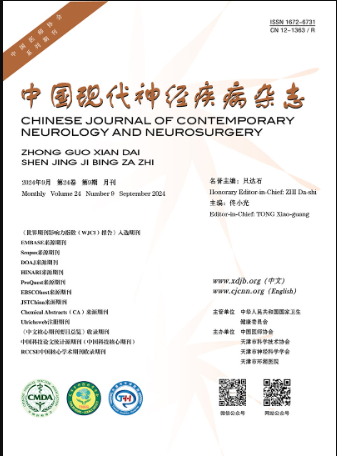Management of stenosis lesions during the period of endovascular treatment for acute ischemic stroke
Q4 Medicine
引用次数: 0
Abstract
Objective To investigate the management of stenosis lesions during endovascular treatment for acute ischemic stroke. Methods A total of 36 acute ischemic stroke patients combined with intracranial/extracranial arterial stenosis were treated with endovascular treatment or bridging treatment. Time from aggravation on admission or in hospital stay to femoral artery puncture, from femoral arterypuncture to recanalization were recorded. Modified Thrombolysis in Cerebral Infarction (mTICI) was usedto assess the recanalization immediately after operation. Modified Rankin Scale (mRS) was used to evaluate prognosis at 90 d after operation. Occurrence rate of symptomatic intracranial hemorrhage and mortality were recorded. Results Among 36 patients, 13 patients (36.11%) underwent intravenous thrombolysis and then endovascular thrombectomy. In all patients, there were 21 (58.33%) with intracranial stenosis and 15 (41.67%) with extracranial stenosis, 16 (44.44%) with anterior circulation stenosis and 20 (55.56%) with posterior circulation stenosis. Stent thrombectomy was used in 25 patients (69.44% ), while balloon dilatation and/or stent implantation was used in 11 patients (30.56% ). For 21 patients with intracranial arterial stenosis, 4 were treated with balloon dilatation only, 9 with Wingspan self-expandable stents and 8 with Apollo balloon-expandable stents. Fifteen patients with extracranial arterial stenosis were treated with balloon dilatation and stent implantation. A total of 33 patients (91.67%) achieved recanalization (mTICI 2b-3 grade), 21 patients (58.33% ) had good outcomes (mRS ≤ 2 score), while symptomatic intracranial hemorrhage occurred in 2 patients (5.56%) and 5 (13.89%) died. There were no statistically significant differences in the rate of good prognosis, symptomatic intracranial hemorrhage and mortality between intracranial and extracranial arterial stenosis, anterior and posterior circulation stenosis (Fisher exact probability: P > 0.05, for all). Conclusions For acute ischemic stroke patients combined with intracranial/extracranial arterial stenosis, endovascular treatment is safe and effective. DOI: 10.3969/j.issn.1672-6731.2017.11.007急性缺血性脑卒中血管内治疗期间狭窄病变的处理
目的探讨急性缺血性脑卒中血管内治疗过程中狭窄病变的处理。方法对36例急性缺血性脑卒中合并颅内/颅外动脉狭窄患者行血管内治疗或桥接治疗。记录患者入院或住院时病情加重至股动脉穿刺、股动脉穿刺至再通的时间。采用改良脑梗死溶栓(mTICI)评价术后立即再通情况。术后90 d采用改良Rankin评分法(mRS)评价预后。记录症状性颅内出血发生率及病死率。结果36例患者中,13例(36.11%)行静脉溶栓后血管内取栓术。所有患者中颅内狭窄21例(58.33%),颅外狭窄15例(41.67%),前循环狭窄16例(44.44%),后循环狭窄20例(55.56%)。支架取栓25例(69.44%),球囊扩张和/或支架植入术11例(30.56%)。21例颅内动脉狭窄患者中,仅行球囊扩张治疗4例,翼展自扩张支架治疗9例,阿波罗球囊扩张支架治疗8例。对15例颅外动脉狭窄患者行球囊扩张及支架置入术。共33例(91.67%)患者实现再通(mTICI 2b-3级),21例(58.33%)患者预后良好(mRS≤2分),2例(5.56%)患者出现症状性颅内出血,5例(13.89%)患者死亡。颅内、颅外动脉狭窄、前后循环狭窄组预后良好率、症状性颅内出血率及病死率比较,差异均无统计学意义(Fisher精确概率:P < 0.05)。结论对于急性缺血性脑卒中合并颅内/颅外动脉狭窄患者,血管内治疗安全有效。DOI: 10.3969 / j.issn.1672-6731.2017.11.007
本文章由计算机程序翻译,如有差异,请以英文原文为准。
求助全文
约1分钟内获得全文
求助全文

 求助内容:
求助内容: 应助结果提醒方式:
应助结果提醒方式:


